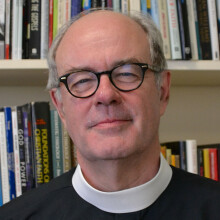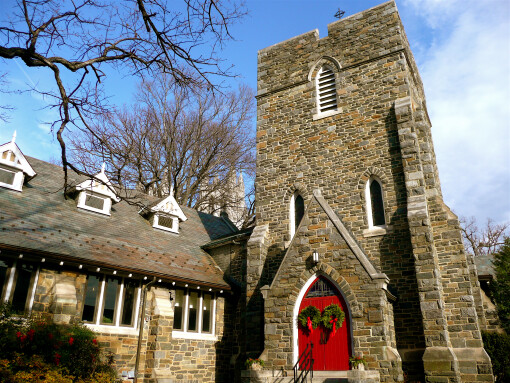Friends and Enemies

Series: Holy Week
Speaker: The Rev'd Geoffrey M. St J. Hoare
Every one of us knows something of the chaos that is wrought by conflict-avoidant leadership. Of course no one really enjoys conflict but when we fail to take the responsibility that is properly ours, acting out of our integrity, and taking the heat when necessary, then we can expect that someone somewhere is going to pay the price. Neither Pilate nor Herod wanted to take responsibility for condemning Jesus to death. The consequence was that they both bore responsibility for allowing this travesty to happen. No one is innocent in Luke’s telling of the story –the the elders of the people, both chief priests and scribes, then the assembly who “rose as a body” and finally the crowds join in insisting that Jesus “stirs up the people by teaching throughout all Judea, from Galilee where he began even to this place.” But it is Pilate and Herod who want to curry favor with the crowds, who make their decisions based on the polls, who see which way the wind is blowing and who acquiesce against their better judgment. “Pilate said to the chief priests and the crowds ‘I find no basis for an accusation against this man.’ But they were insistent…”
And this part of this most horrible and shameful story ends with the most chilling recognition of a fundamental way in which do violence to one another or acquiesce in it: “That same day Herod and Pilate became friends with each other; before this they had been enemies.”
The price of everyone being able to get along was the most profound injustice ensuring that Jesus is on his way to Calvary and to a degrading and awful death at the hands of the state. Jesus, in the events of this whole story, unveils the mechanisms by which we do violence to one another and these mechanisms almost always involve some kind of ganging up, some kind of ‘over against-ness’, some measure of ‘them and us’. We can find this truism in just about any of the great stories of our culture from the Bible to Shakespeare to the mythology of pilgrim Thanksgiving. But perhaps most classically we find it going on in families. It works like this: two parents have some unspoken anxiety about their relationship. Do I still love this person? Why don’t I feel the same way I did at the beginning? What do I do about unacceptable desires that arise and I cannot bring myself to talk about them? To go down the path of honest conversation even if it is only with God and not with the other, is profoundly threatening to this most central relationship of co-parenting. And so what will frequently happen is that these parents will begin to find a degree of renewed togetherness and purpose in their being together at all by focusing their anxiety on one or more of their children. This feels pretty good as they start noticing every little nuance in their child’s life and seeing this or that behavior as a symptom of some problem that needs to be solved or condition that needs to be fixed. Inevitably that child will begin to be even more symptomatic, --perhaps struggling in school, --perhaps manifesting depression, --perhaps experimenting with drugs, --or perhaps just being uncommunicative and surly. It doesn’t really matter how the anxiety is made manifest. It matters that it is made manifest because that child cannot possibly bear the weight of the unspoken anxiety between his or her parents. The price of their ersatz togetherness and feelings of righteous concern for their child is effective violence being done to that same child they are so busy ‘loving’.
This sense of togetherness at the expense of some ‘other’ be it someone we purport to love or someone we consider an enemy is usually blessed as holy or sacred in some way. Consider how we often find ourselves turning the idea of ‘family’ into an idol of sorts or how our response of national unity after 9/11 led, in effect, to a holy war in the minds of many, or how the burning of Notre Dame is bringing about a kind of unity that appears to overcome for now profound differences in French society, symbolized by the yellow vest movement. I ownder wht will happen to those hungering and thirsting for righteousness once that national unity becomes the only permissible voice heard in that land. We see an attempt to create this kind of righteous unity at the expense of another when our own politicians appeal to their base, calling for unity over against the President in one camp and immigrants in another. Whatever we believe to be right and I’m not drawing a false equivalence here, --whatever we believe to b e right, we are all somewhat vulnerable to enjoying a sense of common cause over against another and blessing that togetherness as something like ‘holy’ or ‘sacred’.
Our story this day, unveils for all time the myth of redemptive violence. There is nothing redemptive in this mechanism in spite of our many attempts to make meaning out of something as dreadful as putting a man to death to settle down the anxiety of the religious and political leaders of the day. From now on we must check ourselves at every turn as we seek to manage the challenges of our lives lest we end up avoiding hard truths and thereby causing others to bear the weight of our anxieties, a somewhat unconscious act of violence. Perhaps we can hear how profoundly chilling is that little sentence in the midst of our story, almost a trope for the whole thing. “That same day Herod and Pilate became friends with each other; before this they had been enemies.” “That same day Herod and Pilate became friends with each other; before this they had been enemies.”
 Welcome to St. Alban’s Church! Every Sunday, and most days in between, people gather in this place to worship, to learn, to grow, to share the joys and struggles of our lives, and to seek God’s grace in the midst of our lives. We do not come because we have it all figured out, but because we are seeking light on the way. We come as we are and welcome one another.
Welcome to St. Alban’s Church! Every Sunday, and most days in between, people gather in this place to worship, to learn, to grow, to share the joys and struggles of our lives, and to seek God’s grace in the midst of our lives. We do not come because we have it all figured out, but because we are seeking light on the way. We come as we are and welcome one another.

